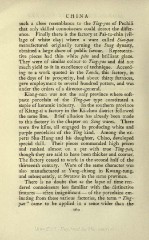Page 322 - Oriental Series Japan and China, Brinkly
P. 322
CHINA
such a close resemblance to the Ting-yao of Pechili
that only skilled connoisseurs could detect the differ-
ence. Finally there is the factory at Pai-tu-chin (vil-
lage of white clay) where a ware called Siao-yao
manufactured originally turning the Sung dynasty,
obtained a large share of public favour. Representa-
tive pieces had thin white pate and brilliant glaze.
They were of similar colour to Ting-yao and did not
much yield to it in excellence of technique. Accord-
ing to a work quoted in the Tao-lu, this factory, in
the days of its prosperity, had about thirty furnaces,
gave employment to several hundred potters, and was
under the orders of a director-general.
Kiang-nan was not the only province where soft-
paste porcelain of the Ting-yao type constituted a
staple of keramic industry. In the southern province
of Kiang-si a factory in the Ki-chou district followed
the same line. Brief allusion has already been made
to this factory in the chapter on Sung wares. There
were five kilns, all engaged in producing white and
purple porcelains of the Ting kind. Among the ex-
perts Shu-Hung and his daughter, Chiao, developed
special skill. Their pieces commanded high prices
and ranked almost on a par with true Ting-yao,
though they are said to have been thicker and coarser.
The factory ceased to work in the second half of the
thirteenth century. Ware of the same character was
also manufactured at Yang-chiang in Kwang-tung,
and subsequently, at Swatow in the same province.
There is no doubt that as the lapse of time ren-
dered connoisseurs less familiar with the distinctive
features often insignificant of the porcelains em-
factories, the term " Ting-
yianoat"incgafmreomtothbesee various in a sense wider than the
applied
260

